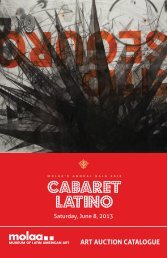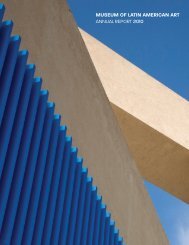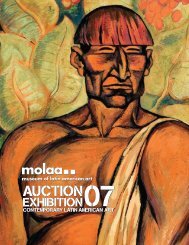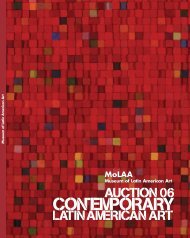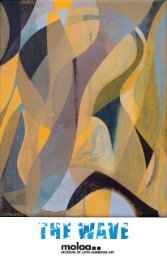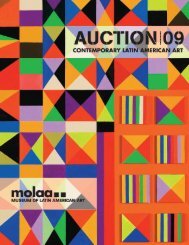FALL 12 ■ VOLUME 6 ISSUE 4
Layout 2 - Museum of Latin American Art
Layout 2 - Museum of Latin American Art
- No tags were found...
You also want an ePaper? Increase the reach of your titles
YUMPU automatically turns print PDFs into web optimized ePapers that Google loves.
PERMANENT COLLECTIONRECENT ACQUISITIONSexperimenting from the 1940s through 1980.Although in recent years the unique body ofabstract work by Matiz has gained attention, itwas not recognized during his lifetime, eventhough his figurative photography was wellestablished. However, he insisted on continuingto develop his body of work that focused onabstraction. It was not until 2005 that manyunpublished photographs and others printedposthumously were exhibited in Bogotá andMexico and shown last year in the exhibitionCold America, Geometric Abstraction in LatinAmerica, at the Fundación Juan March, Madrid,curated by Osbel Suárez. Caracas: Homage toMondrian is an abstract photograph formed by acomposition of buildings under construction,scaffoldings, metal bars and foliage, representingthe birth of Modernism in Caracas in the 1950s.The grid of vertical and horizontal lines refers tothe work of Piet Mondrian (1872-1944), animportant leader of the development of abstractpainting who was also a reference for many LatinAmerican artists working with abstraction.MOLAA is proud to present the following recent acquisitions to our PermanentCollection: On the Construction of the Real Tower of Babel, 1996, by Cuban artistCarlos Garaicoa (b. 1967); Diablitos, Tijuana, and Escaleras, Tijuana, both from2004, by Ingrid Hernández (Mexico, b. 1974); Caracas: Homage to Mondrian, 1950,by Leo Matiz (Colombia, b. 1918-1998); Mickey/Novia from the series Disguise,by Liliana Porter (Argentina, b. 1941) and Big Bang, 20<strong>12</strong>, by Rubén Ortiz-Torres(México, b. 1964). These works have been on display at MOLAA in variousexhibitions throughout the year.Carlos Garaicoa’s work focuses on how historyand the socio-political situation of Cuba becomevisible in its architecture. By creating installations,videos, or photographs, always within the contextof Cuba, the artist explores the ironies of moderncities in ruins and the need for political commitmenttowards architecture, reinventing places andurban solutions through fiction. In the last threedecades, the architecture in Cuba has turnedinto a nostalgic ruin due to the abandonment ofurban projects after the fall of European socialismand the decline of the Cuban economy, leavingcities such as Havana in a dream-like time halt.Acerca de la Construccion de la Verdadera Torrede Babel, 1996, is a commentary on ruins andutopia, as well as an example of the representationof landscape based in a real place with theincorporation of elements of the imagination.Garaicoa draws a critical but sentimentalarchitectural solution next to the photograph ofurban space in ruins in Havana, which is unfeasibleand absurd. Ingrid Hernández is interested inalternative modes of living and subverting thestereotype of poverty by focusing on domesticspaces, so that people don’t see these forms ofliving with pity or exoticism. For the artist, thedomestic space is where people project beliefs,desires and expectations. Intimate spaces are asort of “psychological geography transported tothe realm of objects.” The photographs Diablitos,Tijuana and Escaleras, Tijuana, are part of herseries titled Compressed Tijuana, 2005, whichwas a project in the settlement of “New Hope”(colonia Nueva Esperanza) in Tijuana. Hernándezstudied the urban growth of the settlement,interviewed the residents on themes about family,migration, socioeconomic issues, their personalperception of the settlement, quality of housingand communal organization. At the end of theproject (December 2005) she had an exhibitionof her photos in Nueva Esperanza, where thecommunity was able to see the images andexchange feedback. The works by Ingrid Hernándezand Carlos Garaicoa were included in the exhibition1 1Anywhere Better Than This Place: Selectionsfrom MOLAA’s Permanent Collection (January<strong>12</strong>–June 30, 20<strong>12</strong>) curated by Selene Preciado.2MOLAA acquired the following work thanks to thekind donations of artists, galleries and collectorsto our 1st Exhibition Fund Auction, The Wave,organized by MOLAA’s curatorial department(May <strong>12</strong>, 20<strong>12</strong>). In some cases, works that werenot sold were added to our permanent collection.Liliana Porter is an artist who since the sixtieshas been experimenting with conceptual art,photography and video, as well as the mediumsof painting, drawing and collage. Her work playswith our understanding of time and realitythrough the use of inanimate objects and narrativesthat are activated by the gaze of the viewer andin constructed vignettes of situations that can beinterpreted politically or philosophically. Mickey /Novia, 2009, is part of the series Disguise, whichincludes <strong>12</strong> photographs of figurines with masksand disguises, fulfilling their desire to becomesomeone or something else. In this series, Porterresorts to her use of found objects that sheobtains in flea markets or antique stores, creatingpoetic and eerie settings with unusual charactersand dialogues that reflect the distress andbanality of the human condition.Big Bang, 20<strong>12</strong>, is a work that was produced forMOLAA’s first interactive art exhibition Play withMe (June 16–September 1, 20<strong>12</strong>) and donated tothe Museum by Rubén Ortiz-Torres, a Mexicanartist who has lived in Los Angeles since 1990. Inhis work, characterized by his analysis of postcolonialismand globalization, he utilizes a widearray of mediums including painting, photography,video, mixed-media, collage and everydayobjects. He challenges the way we viewand understand “high” and “low” art and popularculture. Trained initially as a painter, his preoccupationwith the medium of paint has gone beyond theaestheticism and purism of abstraction, especiallysince the early 2000s when he began toincorporate elements of lowrider culture throughthe use of auto painting techniques in his works.Ortiz-Torres titled one of the first series of paintingswhere he used these techniques, Impure Beauty,in reference to artist John Baldessari, whosevisual juxtapositions and pop culture referencesin his work have set a precedent for manycontemporary artists working within this particularlanguage. Impure Beauty was composed ofimages of silkscreened camouflage patterns with“chameleon” paint, which changed colordepending on how light hit the surface. Continuingwith his interest in the parallels between theintricate process of car painting and traditionaloil painting, which includes the preparation, priming,and different base coating of the surface, he hasbeen experimenting with “candy” paint, whichhas a finish similar to “Finish Fetish” works fromthe 1960s—a movement by artists whose workswere handcrafted but purposefully made toseem too perfect, as if they were made bymachines. Big Bang, 20<strong>12</strong> belongs to a recentseries of works made with thermo-chromic paint;a paint which is sensitive to heat and changescolor when touched, due to body temperature.Ortiz-Torres’ intention is to subvert the role of thevisitor in front of a painting, which traditionally isonly to look at it, inviting him/her to “complete”the composition with markings produced byhis/her body.Caracas: Homage to Mondrian, 1950/2011, is onview in Tell me a Tall Story (July 15–November 30,20<strong>12</strong>), the current permanent collection exhibitionat MOLAA curated by Idurre Alonso. Leo Matiz isa pioneer of abstract photography in Latin America,3These six works are a selection from acquisitionsmade from December 2011 through June 20<strong>12</strong>.The thought-provoking work by Rubén Ortiz-Torres’expands the scope of MOLAA’s painting collectionby including this experimental and interactivepainting that requires the participation of thepublic to be completed. The photographic workslisted above enhance MOLAA’s photographycollection, whose development has been thefocus of curator Idurre Alonso. The photographsincorporate the presence of important figuressuch as Modern photographer Leo Matiz,internationally recognized artist Carlos Garaicoaand the young artist Ingrid Hernández.IMAGE CREDITS:1.CARLOS GARAICOA (CUBA, B. 1967)Acerca de la Construcción de la Verdadera Torre de Babel/ On the Construction of the Real Tower of Babel, 1996Print and photoGift of Geoffrey BeaumontM.2011.0<strong>12</strong>.a-b2.LILIANA PORTER (Argentina, b. 1941)Lulu from the series Disguise, 2009Solar printGift of the artistM.20<strong>12</strong>.0093.LEO MATIZ (Colombia, 1918-1998)Caracas: Homage to Mondrian/Caracas: Homenaje a Mondrian, 1950/2011Gelatin silver print on paperGift of the Leo Matiz FoundationM.20<strong>12</strong>.0014 – EXHIBITIONSEXHIBITIONS – 5



